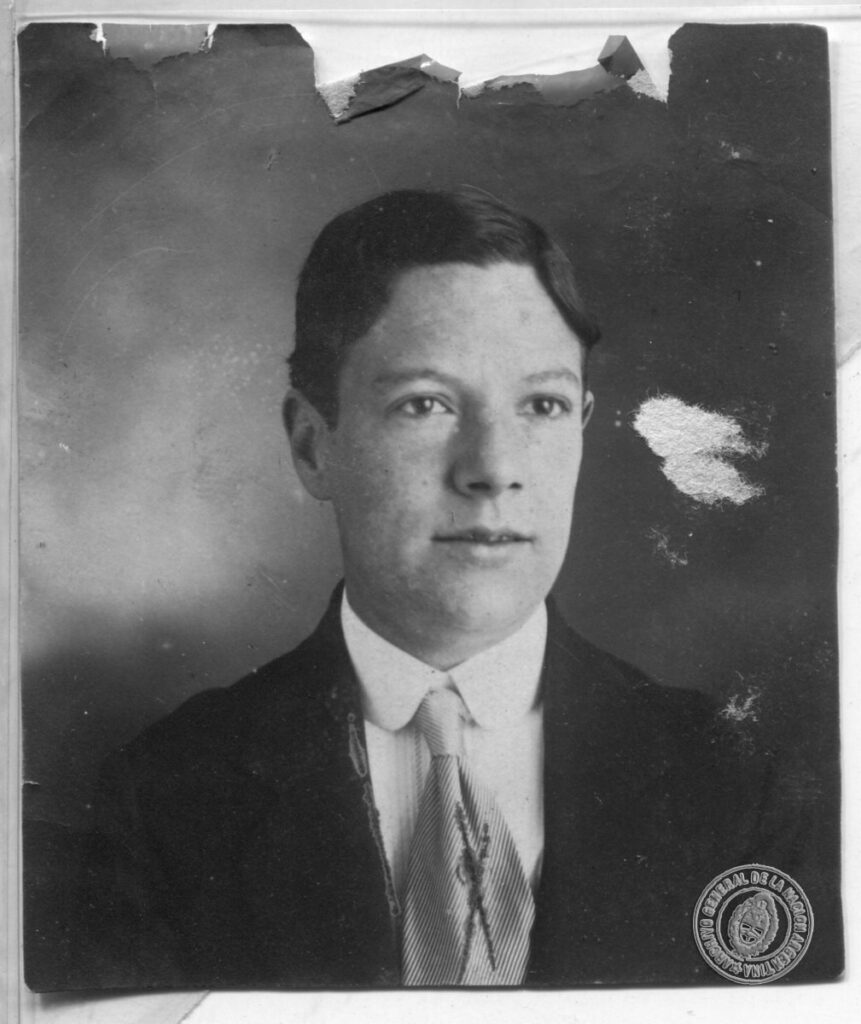Raúl Luis Suarez’s cedula (identity card), which he first obtained in the 1910s, shows him neatly combed, wearing a tie and jacket. He smirks into the camera, an unexpected gesture in this official document that is meant to be emotionless. Nevertheless, it seems he couldn’t help himself from expressing just a little joy. Why? Maybe he was celebrating that the photograph sealed his pact with the state: Raúl was officially a male citizen, and he would be recognized as such until his death in 1930.

Raúl Luis Suárez, called Raquel at birth, was born in 1882 in La Coruña, Spain. His parents, the baker Modesto Suárez and the dressmaker Isidora Valdez, migrated to Uruguay in 1886 with their daughters Raquel and Ada. Some years later they moved to La Plata, Argentina. After Modesto died, they moved to Buenos Aires for work, where his mother became a house cleaner until she died in 1895. Both sisters ended up in a religious orphanage. Raquel escaped, surviving alone until, at the age of 22, she was able to claim her younger sister. The two worked as dressmakers, a popular job among lower-class women at this time.
In 1908, after Ada married, Raquel travelled to Montevideo and forged his birth certificate to be recognized as Raúl Luis Suárez. Raúl then married Amalia Gómez in 1912. He was well known in his neighbourhood for flirting with women and some months later he moved in with his lover Matilde, abandoning Amalia. He got a job in the customs office and participated in a rich social life with other men until, one day in 1930, he fainted and was hospitalized. The doctors were surprised by the genitals they found under his suit. Back home, he collapsed and died. Journalists promulgated that he died from the emotional distress produced by the discovery of his “true sex.” Other joutnalists accused Matilde of murdering him by poison.
After his death Raúl’s body became a battlefield. Doctors accused him of being a liar. They removed his clothes to observe him as a specimen reduced and redefined by his “nature”; they penetrated his body to search for what they considered the immutable nature of his “true sex”. Doctors concluded that Raúl’s “true sex” was female and restored the name his parents had given him. After years of cultivating a male identity through his clothes, his pose for the camera, by forging documents and perhaps changing the tone of his voice, doctors quickly destroyed it all.
The press worked toward the same goal, reporting his case widely and calling him a mujer-hombre (woman-man), a popular term for those who expressed a different gender from the one assigned at birth. Pictures that Raúl had taken with his friends or at the office were published to contrast with those of Raquel. Journalists put forward various theories to explain why Raquel became Raúl. Some suggested that Raúl sought opportunities banned to women in the labour market; others thought his transformation was a tactic to have sex with women.
Finally, Raúl’s body was archived. I found his pictures in the National General Archive of Agentina. I was surprised, along with Raúl’s pictures, to find other so-called mujeres-hombres, almost all of them under the label “female figures.” As historians know, the archive is ruthless in preserving categories over time. Raúl’s male embodiment was forcibly placed in a category to which it would hardly fit and tells us a lot about the sexual sciences at the beginning of the century, as well as how the state extended its sovereignty over sex. Likewise, it tells us about the repertoires of male embodiment: the clothing, activities, gestures, objects, poses and experiences articulated in the everyday making of masculinity.
Raúl’s story is one of the dozens I am exploring in my current book project about the making of ‘sex change’ in Argentina. In contrast to the cruelty of the archive, its ruthless need to mark and reinforce its own categories of “natural” belonging, I employ an epistemology that distrusts the labels of the archive and instead engages with people’s own self-perception. I seek to recover self-made stories and build new narratives to understand how one’s sex could be experienced and expressed over time. Raúl’s smile somehow destabilizes the attempts of the archive to reduce him to his genitalia.
This project has received funding from the European Union’s Horizon 2020 research and innovation programme under the Marie-Sklodowka Curie grant number 886496.
 Patricio Simonetto is a Marie Skłodowska-Curie Fellow at the Institute of the Americas – University College London. He is the author of ‘Between Injury and Revolution. The Frente de Liberación Homosexual in Argentina’ [‘Entre la injuria y la revolución. El Frente de Liberación Homosexual en la Argentina‘] (2017) and ‘Money is not everything. The purchase and sale of sex in Argentina in the 20th century’ [‘El dinero no es todo. La compra y venta de sexo en la Argentina del siglo XX’] (2019).
Patricio Simonetto is a Marie Skłodowska-Curie Fellow at the Institute of the Americas – University College London. He is the author of ‘Between Injury and Revolution. The Frente de Liberación Homosexual in Argentina’ [‘Entre la injuria y la revolución. El Frente de Liberación Homosexual en la Argentina‘] (2017) and ‘Money is not everything. The purchase and sale of sex in Argentina in the 20th century’ [‘El dinero no es todo. La compra y venta de sexo en la Argentina del siglo XX’] (2019).

NOTCHES: (re)marks on the history of sexuality is licensed under a Creative Commons Attribution-NonCommercial-NoDerivatives 4.0 International License.
Based on a work at www.notchesblog.com.
For permission to publish any NOTCHES post in whole or in part please contact the editors at NotchesBlog@gmail.com




